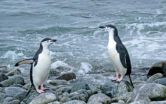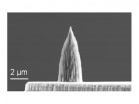(Press-News.org) CAMBRIDGE, Mass. -- On its surface, operating a military drone looks a lot like playing a video game: Operators sit at workstations, manipulating joysticks to remotely adjust a drone's pitch and elevation, while grainy images from the vehicle's camera project onto a computer screen. An operator can issue a command to fire if an image reveals a hostile target, but such adrenaline-charged moments are few and far between.
Instead, a drone operator — often a seasoned fighter pilot — spends most of his shift watching and waiting, as automated systems keep the vehicle running. Such shifts can last up to 12 hours, as is the case for operators of the MQ-1 Predator, a missile-loaded unmanned aerial vehicle (UAV) used by the U.S. Air Force for overseas surveillance and combat.
"You might park a UAV over a house, waiting for someone to come in or come out, and that's where the boredom comes in," says Mary "Missy" Cummings, associate professor of aeronautics and astronautics at MIT. "It turns out it's a much bigger problem in any system where a human is effectively babysitting the automation."
Cummings says such unstimulating work environments can impair performance, making it difficult for an operator to jump into action in the rare instances when human input is needed. She and researchers in MIT's Humans and Automation Lab are investigating how people interact with automated systems, and are looking for ways to improve UAV operator performance.
In a study to be published in the journal Interacting with Computers, Cummings' team found that operators working with UAV simulations were less bored, and performed better, with a little distraction. While the study's top performer spent the majority of time concentrating on the simulation, the participants with the next-highest scores performed almost as well, even though they were distracted nearly one-third of the time.
The findings suggest that distractions may help avoid boredom, keeping people alert during otherwise-tedious downtimes.
"We know that pilots aren't always looking out the window, and we know that people don't always pay attention in whatever they're doing," Cummings says. "The question is: Can you get people to pay attention enough, at the right time, to keep the system performing at a high degree?"
Keeping boredom at bay
The researchers set up an experiment in which participants interacted with a UAV simulation in four-hour shifts. During the simulation, subjects monitored the activity of four UAVs, and created "search tasks," or areas in the terrain for UAVs to investigate. Once a UAV identified a target, participants labeled it as hostile or friendly, based on a color-coded system. For hostile targets, subjects issued a command for a UAV to fire, destroying a target, and earning points in the simulation.
The researchers videotaped each participant throughout the experiment, noting when an operator was engaged with the system, and when he or she was distracted and facing away from the computer screen.
The person with the highest score overall was the one who paid the most attention to the simulation. "She's the person we'd like to clone for a boring, low-workload environment," Cummings says — but such a work ethic may not be the norm among most operators.
Cummings and her colleagues found that the next-best performers — who scored almost as high — were distracted 30 percent of the time, either checking their cellphones, reading a book, or getting up to snack.
The team also found that while the simulation only required human input 5 percent of the time, most people "made themselves busy" in the simulation for 11 percent of the time — an indication that participants wanted more to do, to keep from getting bored.
Cummings says creating busywork or distractions once in a while may, in fact, be good for productivity, keeping an operator engaged when he or she may otherwise lose focus.
Personality complex
Cummings says personality may also be a consideration in hiring UAV operators. In the same experiment, she asked participants to fill out a personality survey that ranked them in five categories: extroversion, agreeableness, conscientiousness, neuroticism and openness to experience. The group found among the top performers, conscientiousness was a common personality trait. Cummings says conscientious people may work well in low-taskload environments such as UAV operation — although she says they may also hesitate when the time comes to fire a weapon.
"You could have a Catch-22," Cummings says. "If you're high on conscientiousness, you might be good to watch a nuclear reactor, but whether these same people would be effective in such military settings is unclear."
Cummings' group is continuing to run experiments to tease out conditions that may improve performance and discourage boredom: For example, periodic alerts may redirect an operator's attention. The group is also looking into shift duration, and the optimal period for operator productivity.
"We need people who can monitor these systems and intervene, but that might not be very often," Cummings says. "This will be a much bigger problem in five to 10 years because we're going to have so much more automation in our world."
###
Written by Jennifer Chu, MIT News Office
Driving drones can be a drag
Study shows distractions may alleviate boredom and improve drone operators' performance
2012-11-14
ELSE PRESS RELEASES FROM THIS DATE:
Queen's research gives fresh hope to couples with 'unexplained infertility'
2012-11-14
New research from Queen's University Belfast has uncovered the cause of infertility for 80 per cent of couples previously diagnosed with 'unexplained infertility'.
At present some 50,000 couples require fertility treatment across the UK each year, with the figure reaching one million worldwide. Up to one third of these couples are diagnosed with unexplained or idiopathic infertility. This means that, using current tests, neither partner has been diagnosed with any detectable problem.
Published in Reproductive Biomedicine Online, and carried out by Professor Sheena Lewis ...
Cancer therapy -- Nanokey opens tumors to attack
2012-11-14
There are plenty of effective anticancer agents around. The problem is that, very often, they cannot gain access to all the cells in solid tumors. A new gene delivery vehicle may provide a way of making tracks to the heart of the target.
Many types of tumor form a compact mass, like the phalanx formation of Greek antiquity. And although many drugs are known to be toxic to cancer cells, they are often unable to percolate into the inner recesses of the tumor. Upon intravenous administration, for instance, cytotoxic drugs may only be able to penetrate the outermost layers ...
Changing climate, not tourism, seems to be driving decline in chinstrap-penguin populations
2012-11-14
The breeding population of chinstrap penguins has declined significantly as temperatures have rapidly warmed on the Antarctic Peninsula, according to researchers funded in part by the National Science Foundation (NSF).
The study indicates that changing climatic conditions, rather than the impact of tourism, have had the greatest effect on the chinstrap population.
Ron Naveen, founder of a nonprofit science and conservation organization, Oceanites, Inc., of Chevy Chase, Md., documented the decline in a paper published in the journal Polar Biology. Naveen and coauthor ...
Preserving van Gogh's priceless masterpieces
2012-11-14
The chrome yellow pigment that renowned post-Impressionist artist Vincent van Gogh favored in priceless masterpieces like Sunflowers, the Yellow House and Wheatfield with Crows is especially sensitive to certain types of light and should be protected to prevent darkening. That's the conclusion of a series of studies in ACS' journal Analytical Chemistry, which could help preserve masterpieces by van Gogh and contemporaries like Gauguin, Cézanne and others.
Koen Janssens and colleagues explain that the chrome yellow pigment used by van Gogh and others in the 19th and 20th ...
Boosting the sensitivity of airport security screening
2012-11-14
Scientists are reporting a simple way to improve the sensitivity of the test often used to detect traces of explosives on the hands, carry-ons and other possessions of passengers at airport security screening stations. Their report appears in ACS' The Journal of Physical Chemistry C.
Yehuda Zeiri and colleagues explain that most tests for traces of explosives begin by rubbing a swab made from glass fiber, Teflon or cotton over the suspect material. Analysis of the swab in a detector — usually a device called an ion mobility spectrometer — alerts agents to any explosive ...
Ingredient in diarrhea medicine leads to sustainable new farm fertilizer
2012-11-14
The search for a sustainable slow-release fertilizer — a key to sustaining global food production at a time of burgeoning population growth — has led scientists to an ingredient used in some diarrhea medicines. They describe use of the substance, attapulgite, as a "carrier" for plant nutrients in a report in ACS' journal Industrial & Engineering Chemistry Research.
Boli Ni and colleagues explain that about half of the 150 million tons of fertilizer used worldwide every year goes to waste. That's because most fertilizers release nutrients too fast for the crops to use. ...
Nanometer-scale diamond tips improve nano-manufacturing
2012-11-14
One of the most promising innovations of nanotechnology has been the ability to perform rapid nanofabrication using nanometer-scale tips. The fabrication speed can be dramatically increased by using heat. High speed and high temperature have been known to degrade the tip… until now.
"Thermal processing is widely used in manufacturing," according to William King, the College of Engineering Bliss Professor at the University of Illinois at Urbana-Champaign. "We have been working to shrink thermal processing to the nanometer scale, where we can use a nanometer-scale heat ...
Life and death in a star-forming cloud
2012-11-14
The aftershock of a stellar explosion rippling through space is captured in this new view of supernova remnant W44, which combines far-infrared and X-ray data from ESA's Herschel and XMM-Newton space observatories.
W44, located around 10 000 light-years away within a forest of dense star-forming clouds in the constellation of Aquila, the Eagle, is one of the best examples of a supernova remnant interacting with its parent molecular cloud.
The product of a massive star that has already reached the end of its life and expelled its outer layers in a dramatic explosion, ...
You can be a star -- on science's stage
2012-11-14
The rapid growth in "citizen science" projects during the past decade is enabling more and more science enthusiasts, hobbyists, students and other ordinary people to participate in the excitement of real-world scientific research and help solve serious scientific mysteries. That's the topic of the cover story in Chemical & Engineering News (C&EN), the weekly newsmagazine of the American Chemical Society, the world's largest scientific society.
Deirdre Lockwood, C&EN contributing editor, traces the growth of citizen science from the Audubon Christmas Bird Count of 1900 ...
Television: Chronicle of a death foretold?
2012-11-14
Not only is TV not endangered, but it also has a unifying social impact on the nuclear family across the country. This is the main conclusion of a cross-Canada study—Are the Kids All Right?—on the television viewing habits of families with at least one child aged between 9 and 12 years. The study was conducted by a team of researchers led by André H. Caron, professor of communications at Université de Montréal and Director of the Centre for Youth and Media Studies (CYMS).
"Young Canadians today live in a different world than that experienced by previous generations. In ...
LAST 30 PRESS RELEASES:
School meals could unlock major gains for human and planetary health
Menopause hormone therapy does not appear to impact dementia risk
Signature patterns of brain activity may help predict recovery from traumatic brain injury
Dresden study uncovers new key mechanism in cancer cells
New species are now being discovered faster than ever before, study suggests
Cannabis-based products show limited short-term benefit for chronic pain, with increased risk of adverse effects
Cannabis products with more THC slightly reduce pain but cause more side effects
Clearing the brain of aging cells could aid epilepsy and reduce seizures
Brain injuries linked with potential risk of suicide, new study finds
New technique lights up where drugs go in the body, cell by cell
New study finds movement of fishing fleets can reveal shifts in marine ecosystems
Embargoed: New evidence points to potential treatment for vascular dementia
Study uncovers disrupted brain balance in alcohol dependence
Working in groups can help Republicans and Democrats agree on controversial content moderation online
Structural findings reveal how distinct GPCR ligands create different levels of activation
Anything-goes “anyons” may be at the root of surprising quantum experiments
UC review: Maximizing workplace opportunity for veterans
From generation to complex control: Metasurfaces make perfect vortex beams "within reach"
Thin-film lithium niobate-based detector: recent advances and perspectives
Exploring why some people may tend to persistently make bad choices
How cells balance their protein levels
Nirsevimab vs RSVpreF vaccine for RSV–related hospitalization in newborns
Effectiveness and impact of maternal RSV immunization and nirsevimab on medically attended RSV in US children
AI gives scientists a boost, but at the cost of too many mediocre papers
Next-generation vision model maps tree growth at sub-meter precision
Genes aren’t destiny for inherited blindness, study shows
MIT study: High-fat diets make liver cells more likely to become cancerous
Exposure to multiple fine particulate matter components and incident depression in the US Medicare population
Risk of burdensome health care spending over time in the US
Nirsevimab against hospitalizations and emergency department visits for lower respiratory tract infection in infants
[Press-News.org] Driving drones can be a dragStudy shows distractions may alleviate boredom and improve drone operators' performance


